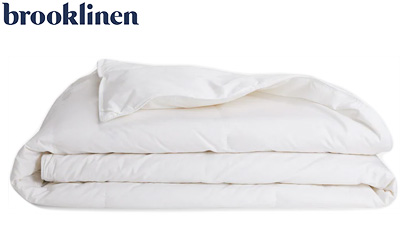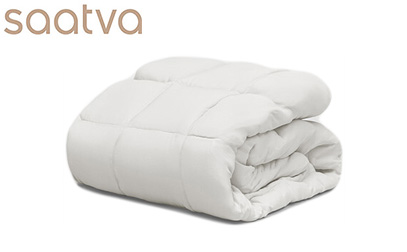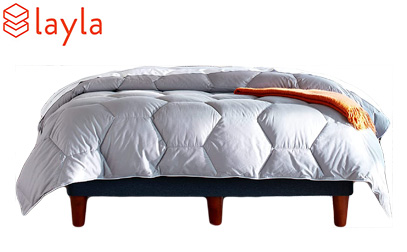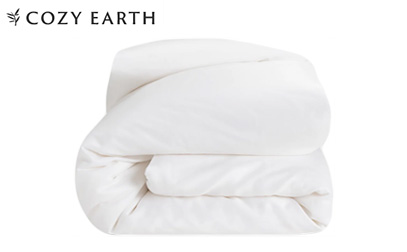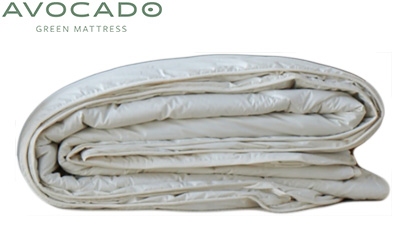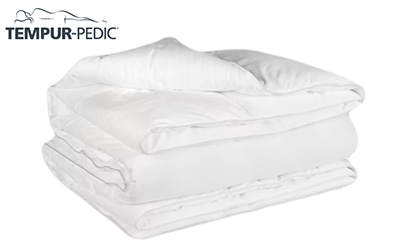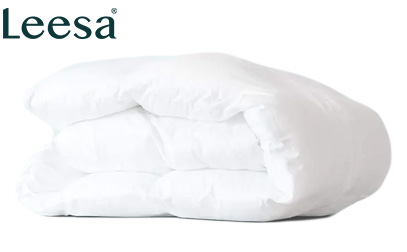Cooling comforters appeal to hot sleepers by providing coziness without unnecessary heat. Although these comforters look and feel similar to what is on your bed now, they feature unique cooling technologies that regulate your temperature and keep you from sweating through your pajamas.
Sometimes, the type of material or fill does the cooling, while in other cases, it’s the cover. Either way, you’ll appreciate these materials if you’re a hot sleeper who still likes to snuggle in a comforter.
The difference between a cooling comforter and a regular one is that the cooling one helps hot sleepers mitigate night sweats, especially during summer.
Why You Can Trust Sleep Advisor
We’ve been around for many years, reviewing mattresses and bedding we test in our studio. Our team consists of professionals with many years of experience in the industry. Plus, we work with doctors and medical professionals to cover different topics related to sleep and health.
At Sleep Advisor, we take our time testing mattresses, pillows, and other bedding using different tools and methods. This allows us to evaluate cooling and other performance categories so we can recommend only the best products.
The Best Cooling Comforters for Hot Sleepers
- Brooklinen Down Comforter Lightweight – Best Overall Cooling Comforter
- Saatva Lightweight Down Alternative Comforter – Most Comfortable Cooling Comforter
- Layla Down Alternative Comforter – Best Value Cooling Comforter
- Cozy Earth Silk Comforter – Best Luxury Cooling Comforter
- Avocado Alpaca Duvet Insert Lightweight – Best Organic Cooling Comforter
- Tempur-Pedic Primaloft Comforter – Best Hypoallergenic Cooling Comforter
- Leesa Duvet Comforter – Best Lightweight Cooling Comforter
7 Best Cooling Comforters
Brooklinen Down Comforter Lightweight – Best Overall Cooling Comforter
Brooklinen Down Comforter
The Brooklinen Down comforter uses natural down and is great for those looking for a really fluffy feel.
Brooklinen Score
4.70 / 5
This Brooklinen down comforter is an excellent option for those who live in a variable climate. The down cluster fill makes it warm in winter and cool in summer. The comforter is lightweight and soft, which we think is a great way of adding luxury and coziness to your bed all year round.
Saatva Lightweight Down Alternative Comforter – Most Comfortable Cooling Comforter
Saatva All-Year Down Alternative Comforter
The Saatva All-Year Comforter is made with a down-alternative and works well for hot sleepers or sleeping in warmer temperatures.
Saatva Score
5.00 / 5
Saatva doesn’t typically disappoint, so we weren’t surprised by how much we liked this cooling comforter. We first noticed that the fill doesn’t pool in one place. Instead, it’s evenly distributed, most likely due to box quilting. The cotton shell has some cooling properties and feels fresh to the touch. However, the star of the show is the filling made from 3D down alternative and lyocell blend.
Layla Down Alternative Comforter – Best Value Cooling Comforter
Layla Comforter
Layla Sleep is known for its memory foam beds and signature hexagon patterns. You’ll find this shape in all of its bedding products, and its comforter is no different. If you’re looking for a soft cotton comforter with a down alternative fill, this is the comforter for you.
Layla Score
4.70 / 5
Value-seekers should like this Layla comforter, which is made to deliver comfort, cooling, and coziness at a wallet friendly price. Its 300-thread-count cotton fabric keeps it crisp and airy, which is great news for hot sleepers. The Layla is also filled with a down alternative and is hypoallergenic, meaning it’s safe for allergy-prone people.
Cozy Earth Silk Comforter – Best Luxury Cooling Comforter
Cozy Earth Silk Comforter
If you’re looking for a luxurious upgrade to your bedding, the Cozy Earth Silk comforter is the perfect fit— featuring 100% Mulberry silk and bamboo viscose.
Cozy Earth Score
5.00 / 5
The Cozy Earth Silk Comforter helps regulate temperature by incorporating cooling materials and a breathable design. This piece has anchor loops, so you can use a duvet cover to ensure it doesn’t shift inside.
Avocado Alpaca Duvet Insert Lightweight – Best Organic Cooling Comforter
Avocado Alpaca Duvet Insert Lightweight
A luxurious, organic duvet insert. Sourced from the Peruvian Andes, Avocado’s alpaca fiber is renowned for its supreme breathability, wicking, and thermoregulating properties.
Avocado Score
4.50 / 5
Avocado knows organic mattresses and bedding. This duvet insert is a prime example of how all-natural materials, like organic cotton and alpaca fibers, can help with temperature regulation.
Tempur-Pedic Primaloft Comforter – Best Hypoallergenic Cooling Comforter
TEMPUR-Pedic PrimaLoft Comforter
The TEMPUR-Pedic PrimaLoft Comforter is airy, soft, and stays cool throughout the night.
TEMPUR-Pedic Score
4.50 / 5
Anyone with allergies knows how hard it is to sleep if you are sneezing. If this is you, consider this Tempur-Pedic comforter. It’s hypoallergenic and should be a good option for those with daily allergies. This comforter features the brand’s proprietary PrimaLoft, which is hypoallergenic and soft.
Leesa Duvet Comforter – Best Lightweight Cooling Comforter
Leesa Duvet Comforter
Made from hypoallergenic, 100% recycled PET microfiber fill that is completely machine washable. Also, it has a 100% breathable cotton shell with square baffles that keep lumps at bay.
Leesa Score
4.70 / 5
If you’re a hot sleeper, a lightweight comforter is what you want, especially for those warm summer nights. The Leesa Duvet Comforter has a breathable organic cotton shell and lightweight fill that won’t make you warmer when you’re already overheating.
What is a Cooling Comforter?
A cooling comforter is built with cooling properties to help hot sleepers rest more easily. The cooling features are the main difference between a regular comforter and a cooling one. The cooling effect usually comes from materials and technologies that make a comforter moisture-wicking, breathable, and temperature-regulating.
Materials like wool and down help with cooling, but some brands may also use proprietary blends for a more unique feel. Both the fill and case have important roles in keeping a person cool, so make sure to check all the materials used.
How to Choose a Cooling Comforter
The bedding market offers a range of comforters suitable for all kinds of sleepers. If you’re a hot sleeper, you should focus on cooling ones. Along with cooling properties, there are other features to consider before buying.
Cooling Features
The cooling features of a comforter make all the difference because, without them, you’d likely feel too warm. Of course, how cool a comforter will feel depends on the materials, so this should be the first thing you check. Look for breathable and moisture-wicking materials that don’t allow the heat to build up. Apart from certain materials, some brands also use cooling technologies to keep the surface cool and crisp.
Cover Material
You might find many different comforters, but you won’t find many options when it comes to the cover materials. Most companies use cotton because it’s naturally breathable and temperature-regulating. Cotton can stay cool during hot weather and warm during the coldest months. If you do come across other materials, make sure they have cooling capabilities, or else they may feel too warm. When it comes to maintenance cover materials that are easy to clean, such as cotton, will be more convenient.
Fill Material
Although the cover is usually made from cotton, fill types vary and can include down, down alternatives, and different proprietary blends and materials. Some even include mulberry silk (we see you, Cozy Earth). Which one you’ll choose depends on your needs, preferences and budget. One thing you should take note of is the overall quality of materials and manufacturing. You’ll want to choose well-made products that can last a long time, even with frequent use.
Price
Cooling comforters are available at various prices, so there’s an option for every budget. You can find comforters between $20 and $1,000, so it’s just a matter of what you’d like to pay. Although you should consider the price, try not to let it be the deciding factor. Some value options can bring excellent comfort and cooling without breaking the bank. Also, keep in mind that the price depends on the materials, size, and cooling features.
Size
Like with cooling sheets and other bedding, brands offer a few sizes to pick from based on your needs. Comforters, including cooling ones, should be a bit bigger than your bed. So even if you get the size that fits, don’t be surprised to see it’s slightly larger. One way to check this beforehand is to see the exact dimensions.
Weight
When we talk about weight with comforters, it usually refers to the amount of fill inside the comforter. This helps you understand how thick the comforter is. Cooling ones are typically lightweight or all-season, whereas those meant for colder months are usually heavyweight.
However, weight can also refer to a weighted cooling comforter with glass beads, which adds some weight for a deep-pressure feel.
Care
If you’ve read each of the mini-reviews above (which I hope you did), you probably noticed that some are machine-washable and others are not. Machine-washable options are not hard to find. However, they typically involve cold temperatures and gentle cycles with no bleach.
Other care options include dry cleaning, which can be an extra expense, and spot cleaning, which can sometimes be ineffective.
Trial and Warranty
Most companies offer a trial and warranty, given that cooling comforters are intended for personal use. In most cases, you’ll come across 1-year warranties and trials that last 30 to 120 days on average. Some companies offer a longer warranty but no trial if they don’t accept bedding accessories back.
Pros and Cons of Cooling Comforters
Cooling comforters have cooling properties that make it easier for hot sleepers to regulate their temperature. They’re not your regular comforter; they’re a cool one.
The most outstanding pro is that these help you sleep without hot flashes and night sweats. The cons are few but worth mentioning because these aren’t for everyone.
Pros
Moisture-wicking
Hot sleepers often sweat. So, when a cooling comforter states that it is moisture-wicking, it means it’s made to help regulate that sweat. How?
It’s fairly simple; moisture-wicking fabric pulls sweat to its surface, drying it quickly so that it doesn’t soak into the fabric. Most cooling comforters, because they’re made for hot sleepers, have some moisture-wicking materials like polyester.
Cool to the touch
Contrary to popular belief, cooling comforters are not always cool to the touch. Some are just temperature-regulating, which is fine, but they won’t stay cool to the touch long after touching your body.
If you’re an extremely hot sleeper who lives in a warm climate or struggles with night sweats, a cool-to-the-touch comforter can help. You’ve guessed it: these are always crisp, no matter the weather.
Versatile
A thermo-regulating comforter is a versatile piece of bedding. It can help hot sleepers feel cooler and cold sleepers feel warmer. In some cases, you can use it as a duvet, adding a cover to it, which is perfect if you like layering your bedding. Depending on its thickness, you can even use it as a mattress cover.
Easy to clean
Comforters are typically easy to clean unless you get an ugly stain on them. Many models are machine-washable, so you can just throw your comforter in the machine and set it on a gentle cycle using a mild detergent. Sometimes, you can even tumble dry it so it’s fluffy and warm for the following night.
Those that aren’t machine-washable might not be as easy to clean, but don’t be afraid. Spot cleaning should be simple enough with warm water and mild detergent. If you get a bad stain on it, dry cleaning might be the only option.
Cons
Not for those who sleep cold
A cooling comforter is not the right option for those who sleep cold because materials such as percale cotton, silk, and lyocell can make you even colder. However, a temperature-regulating comforter might not.
Some models are meant to stay cool throughout the night regardless of your body temperature, whereas others respond to your temperature. Either way, you’re better off avoiding the word “cooling” if you’re a cold sleeper shopping for a comforter.
Too lightweight for some
These comforters are typically lightweight to avoid adding unnecessary heat to those struggling with nighttime sweating. Some people prefer heavier comforters that are fluffier than your regular blanket.
While they usually feel fresh and crisp, some people complain they’re not as fluffy.
Some don’t include a trial period
Some companies don’t include a trial because bedding is for personal use. They don’t accept returns, saying they can’t take back the bedding you’ve used.
Although this is the case with some companies, it’s not set in stone, meaning others offer a trial nonetheless.
Types of Cooling Comforters
- Down – Down comforters are usually the luxury option. These have insulating qualities, which makes them warmer than any other type. However, down is soft, fluffy, and a good choice for those who sometimes sleep cold.
- Down Alternative – Down alternative is polyester or microfiber. These are equally soft and fluffy but not as expensive as down. On top of that, they’re breathable and cool enough for most hot sleepers.
- Cotton – Cotton models are more affordable. These are good at cooling, and they’re also easy to keep clean.
- Wool – Wool has excellent temperature-regulating properties, so it’s a good option if you’re after natural materials. These comforters can keep you warm during winter and wick away moisture during summer.
- Silk – Silk is another luxury option that has natural thermoregulating properties. This material is known for keeping you cold in summer and warm in winter.
Other Ways to Get the Best Cool Sleep
A cooling comforter is great, but if you’re a hot sleeper, you might want to up your game. We’ve tested a range of cooling bedding, starting with mattresses, cooling sheets, blankets, and pillows. These are particularly nice if you also live in a warm climate.
Sleeping with an air conditioner is another way to get the best cool sleep. If an AC is not an option, consider a fan. Fans are great because although they don’t cool the room as much as an AC, they’ll move the air around, making breathing easier in hot weather. If the design of your house allows, you could also move your bedroom downstairs because heat is known to go up.
Frequently Asked Questions
How much does a cooling comforter cost?
A cooling comforter can cost anywhere between $20 and $1,000 depending on the materials, size, weight, and technologies used to bring that cooling effect. As said, it helps to have a budget in mind, but you should also consider other buying factors before making a decision.
What cooling comforter is best for night sweats?
The best cooling comforter for night sweats is a moisture-wicking one. Moisture-wicking materials ensure the sweat dries quickly, doesn’t saturate the fabric, and can even help neutralize odors.
Can you use a cooling comforter year-round?
You could use a cooling comforter all year long if you sleep hot even in colder months, live in warmer client, or find one that adapts to your body temperature. Also, some comforters are advertised as all-season, meaning they should work for both spring, summer, fall and winter.
Do cooling comforters actually work?
This depends on the actual comforter you get and on how hot you sleep. If you have hot flashes, night sweats, or your body heat just cranks up at night, you’ll likely need a comforter with all the bells and whistles, like a cool-to-the-touch cover, moisture-wicking materials, and maximum breathability.
Cooling comforters do work; it’s just a matter of finding the right one that works for you.
What’s the difference between a comforter and a duvet?
A comforter and a duvet are very similar.
The best way to tell duvets apart from comforters is to look at their thickness. A comforter is flat, whereas a duvet is fluffy. Also, a duvet usually needs a cover, which means it’s a two-piece, whereas a comforter does not need a cover. On the other hand, quilts have multiple layers, and blankets have only one. This is why quilts are typically warmer than blankets.

Olivera Jancikin
Content Writer
About Author
Olivera is a content writer for Sleep Advisor and is enthusiastic about sleep. She firmly believes in the benefits of daytime naps on top of getting a full 8-hour sleep at night.
Combination Sleeper

